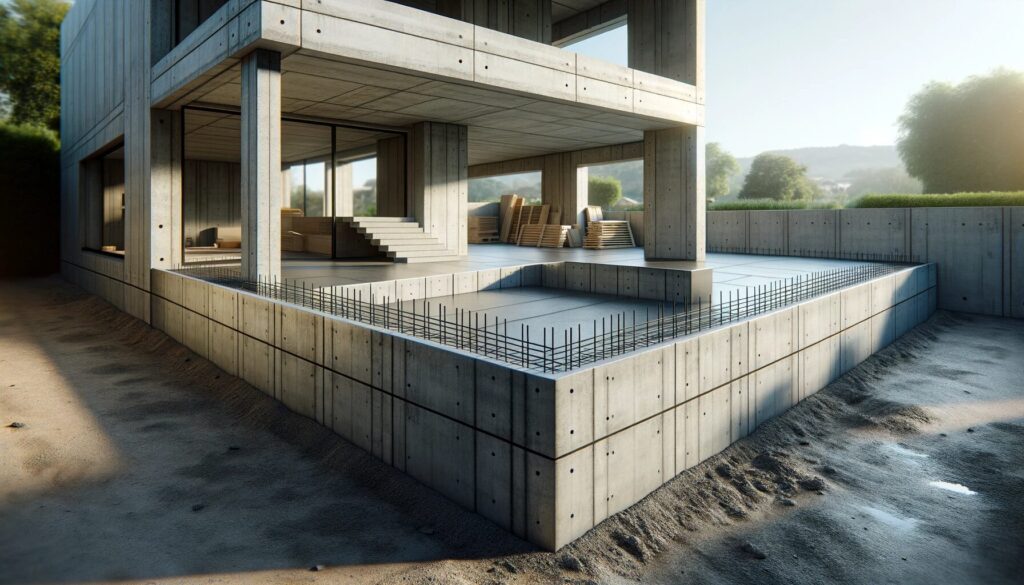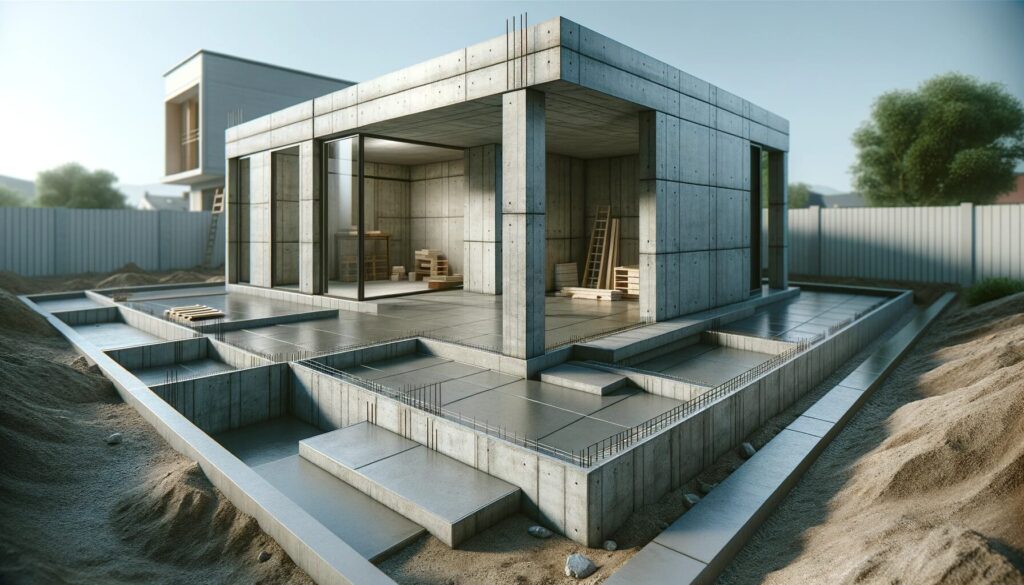When embarking on the journey of home construction, the most critical step is laying a solid foundation. It’s not just the literal base of your home, it’s the element that ensures stability, longevity, and safety. A well-constructed foundation is like the keel of a ship, keeping everything upright and balanced, no matter what storms may come.

Understanding the Basics
The foundation of a house is more than just a platform, it’s a complex system designed to support and stabilize your home. Let’s break it down:
- The Role in Stability: A foundation isn’t just about holding up walls and roofs, it’s about creating a barrier against moisture, providing insulation against the cold, and resisting natural forces. It’s the unsung hero that keeps your house standing through thick and thin.
- Types of Foundations:
- Slab-on-Grade: Ideal for warmer climates, this is a single layer of concrete, thicker at the edges, reinforced with steel bars. It’s straightforward but effective.
- Crawl Space: These elevate the house, providing a small gap underneath. Great for plumbing and electrical access, they also offer some protection against soil moisture.
- Basement Foundations: The most substantial option, basements add living or storage space. They’re deeper, more labor-intensive, but invaluable in colder regions for their added insulation.
- Why Concrete?: Concrete is the go-to for foundations for good reason. It’s tough against pests, fire-resistant, and, with proper composition and curing, lasts for generations.
Planning and Preparation
Constructing a concrete foundation is a process of precision and foresight. Here’s what to consider:
- Site Selection: Your foundation’s success starts with the right location. Look for stable soil, good drainage, and consider the overall landscape.
- Soil Testing: Essential for understanding the ground you’re building on. Different soil types affect load-bearing capacity and dictate the foundation type.
- Design Considerations: Tailor your foundation to your home’s design, climate, and soil. Customization here is key to a lasting foundation.
- Local Building Codes and Regulations: Adhering to local codes ensures safety and compliance. These regulations are your guide to a foundation that’s not just sturdy but also legal.
Materials and Tools
In the realm of concrete foundations, your choice of materials and tools can make or break your project. Let’s get this straight:
- Concrete Mix: Opt for a high-quality concrete mix, preferably a 5-bag mix with a 4,000 psi rating. This is the bedrock of your foundation, no cutting corners here.
- Rebar or Wire Mesh: Think of this as the backbone of your foundation. Rebar is your go-to for structural strength, while wire mesh suits less demanding applications.
- Anchor Bolts: These are the critical links between your structure and its foundation. Embed them in the concrete before it hardens.
- Gravel: A layer of gravel under your slab is not just filler, it’s essential for drainage and preventing upheaval.
- Form Boards: Your forms will shape the concrete. Use sturdy plywood or lumber, and make sure they are well-braced and perfectly level.
- Waterproofing Membrane: An often overlooked but vital component for moisture control.
For tools, here’s your arsenal:
- Shovels and Rakes: For spreading gravel and leveling concrete.
- Tampers: Essential for compacting the base soil and gravel.
- Levels and String Lines: Your best friends for ensuring everything is even and square.
- Concrete Mixer or Wheelbarrow: For mixing your concrete and moving it to the site.
- Trowels: For that smooth finish on your concrete.
- Buckets and Hoses: Stay prepared with water for mixing and cleaning.

The Construction Process
Building a concrete foundation is a journey of precision and patience. Let’s walk through the steps:
- Site Preparation and Ground Leveling: Begin with a clean slate. Remove debris and level the ground. Compact the soil uniformly to prevent future settling.
- Setting Up Formwork for the Foundation: Construct your forms to the exact dimensions of your foundation. Use levels and string lines to ensure everything is square and true. The accuracy here is non-negotiable.
- Laying the Footing: Your footing is the foundation’s foundation. Dig your trenches, following local codes for depth and width. Lay your rebar or wire mesh inside. This step is crucial for the overall stability of your structure.
- Pouring and Curing Concrete: Now, pour your concrete, spreading and leveling as you go. Use a screed board to level the top. The curing process is slow and crucial, keep the concrete moist for at least a week to allow it to gain strength gradually.
- Removing Formwork and Inspecting the Finished Foundation: After curing, remove the forms with care. Inspect your work thoroughly for any imperfections. This is your last chance to catch and fix any issues before building upon it.
Common Mistakes to Avoid
Drawing from years of experience, I’ve seen many enthusiastic DIYers take on foundation projects, often stumbling over the same hurdles. Let’s address these common errors and how you can sidestep them:
- Choosing Inferior Materials: Cutting costs on materials like concrete or rebar is a false economy. Opt for high-grade materials to ensure your foundation’s integrity.
- Overlooking Site Preparation: Properly preparing your site, which includes leveling and compacting the soil, is crucial. A foundation’s strength is compromised if it rests on unsettled or uneven ground.
- Inaccurate Measurements and Leveling: Foundations require precision. An unlevel foundation can lead to significant structural issues. Use precise measurements and leveling tools, not guesswork.
- Ignoring Building Codes: Local building codes are your blueprint for safety and legal compliance. Overlooking these can lead to costly and dangerous mistakes.
- Rushing the Curing Process: Concrete needs time to reach its full strength. Allow it to cure fully, usually around a month, before proceeding with construction.
FAQ Section
The depth of your foundation is dictated by several factors: the soil type, the climate (especially frost lines in colder regions), and the structure’s weight. Typically, foundations extend at least 2-4 feet underground, but always refer to local building standards and consider consulting a structural engineer for specific advice.
Concrete generally takes about 28 days to achieve most of its strength, but it starts to set within 24-48 hours. The curing time can be influenced by external factors such as temperature and humidity. It’s crucial to keep the concrete moist for at least a week to aid the curing process.
This depends on your skill level and the project’s complexity. For small projects like a shed, a DIY approach might be feasible. However, for something as critical as a house foundation, especially if you lack experience, hiring a professional is advisable. The risk of errors in a foundation can have serious repercussions.
Warning signs include visible cracks (particularly horizontal ones), difficulty in closing doors and windows, and uneven floors. These symptoms suggest that the foundation may be compromised and requires attention.
Regular maintenance includes inspecting for and repairing cracks, ensuring proper drainage around the foundation, and monitoring tree roots that may grow too close. Routine checks and maintenance can significantly extend the life of your foundation.
